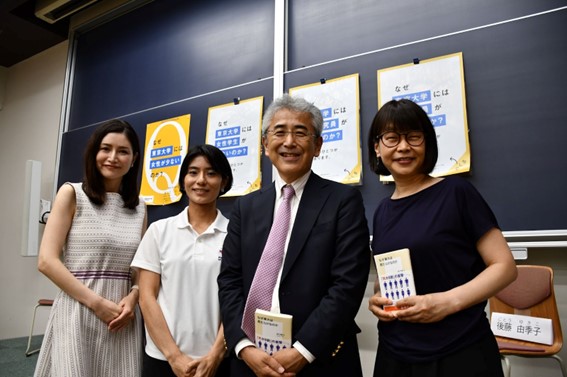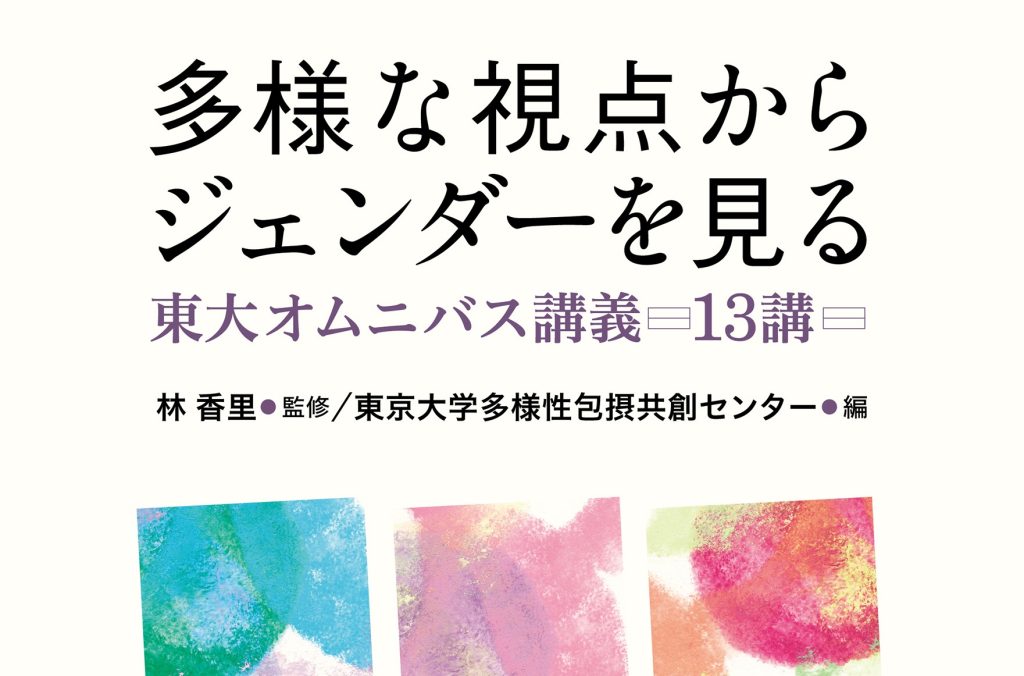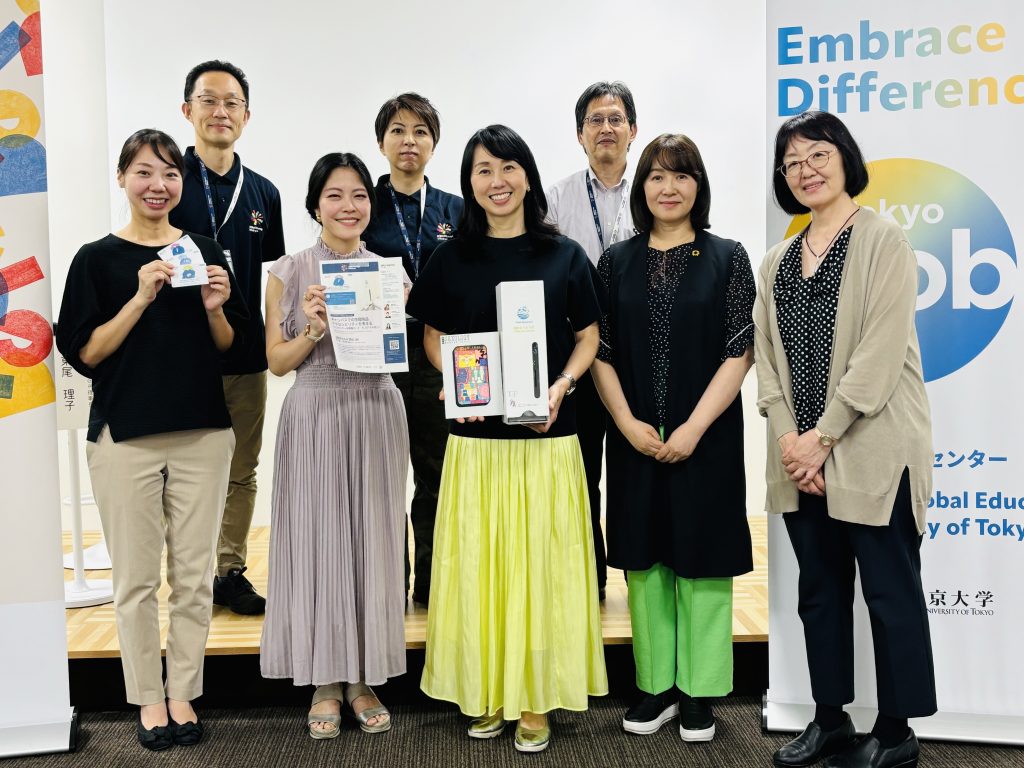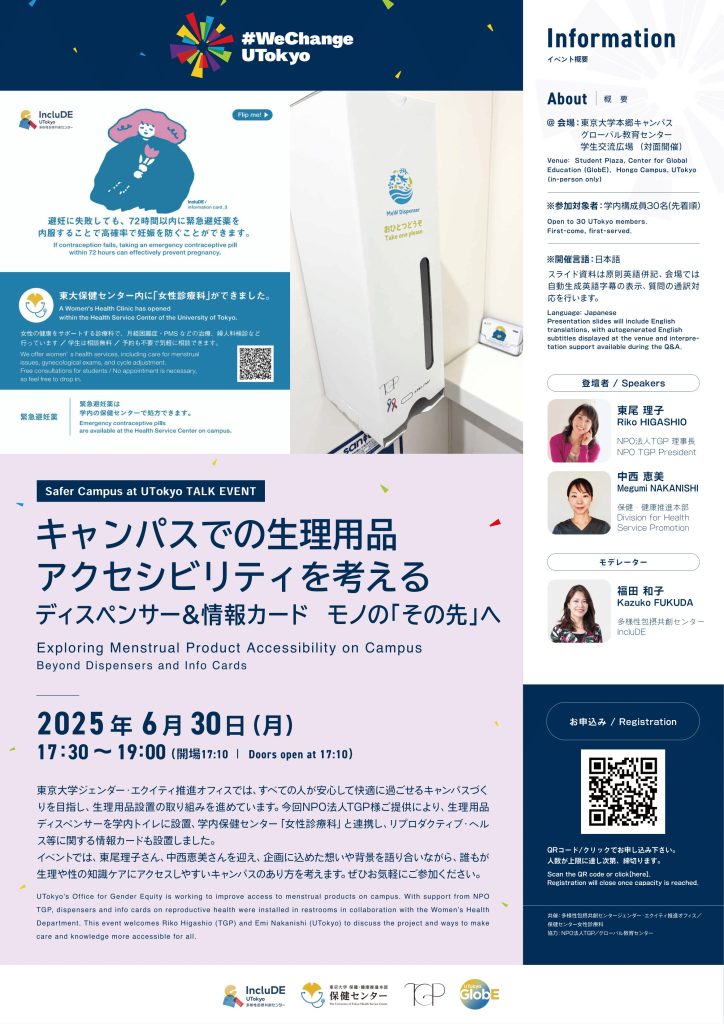On June 26, 2024, the University of Tokyo held a book talk event titled “To Confront and Eliminate #Headwinds.” About forty UTokyo community members gathered to participate in a lively discussion featuring Vice President and Director of the Center for Global Education, Yujin Yaguchi; Professor Yukiko Gotoh of the Graduate School of Pharmaceutical Sciences and Senior Researcher at the International Research Center for Neurointelligence (IRCN); and Mayu Yamaguchi, Specially Appointed Professor at Shinshu University and New York Attorney at Law. The event was moderated by Associate Professor Madoka Nakano of the Center for Co-production of Inclusion, Diversity and Equity (IncluDE).
Impressions of the #Headwinds project
Nakano: How do you perceive the #Headwinds project, which was implemented by the Office for Gender Equity?

Yaguchi: I probably shouldn’t be surprised, but I am disappointed, or rather saddened, to see such negative reactions against women [i.e., sexist statements that appeared in reaction to the #Headwinds poster]. When my book Why Is UTokyo Full of Men? was released, I initially got discouraged because I received some negative comments. But a colleague told me that is what one needs to expect when writing about gender issues. This is a lesson I took to heart. We shouldn’t be defeated by these reactions, and instead we must think about how to overcome them.
Yamaguchi: At first, I thought it was merely a matter of words, and I questioned whether societal change could be achieved simply by modifying language. However, I now believe that the impact of continuous exposure to such language is substantial. The project’s focus on seemingly innocuous comments that can become formidable headwinds is profoundly meaningful.
Gotoh: When I read the phrases on the #Headwinds poster, I realized that I had experienced nearly all of them. It served as a stark reminder of the societal pressure to conform to a specific notion of “femininity” that I experience as a woman living in Japan. When I studied abroad, I encountered women in leadership positions and those who were freely pursuing self-actualization, leading me to understand that the concept of femininity imposed upon me was a social construct unique to Japan. I hope that those currently facing #Headwinds can recognize that this experience is not universal.
Why is the underrepresentation of women a problem?
Nakano: What do you consider the core problem with the underrepresentation of women at UTokyo?
Yaguchi: The underlying message of my book is that the basic structure of the University of Tokyo, which was established as a university by men for men, has not changed from 1877 to the present. I wrote in this book that, because of this male-centered value system and structure, women find it difficult to enter the University of Tokyo, and even after entering, many feel marginalized and often do not want to come back.
Yamaguchi: Like many women who enter UTokyo, I had my doubts about a quota system. However, I live and work in a predominantly male society. In this environment, I’ve had to disclose highly personal information to adjust my work schedule and take breaks, which I found to be a significant mental burden. I believe this stems from being a minority in a male-dominated society. UTokyo is undeniably a leading institution in producing future leaders, yet the female student population remains at only 20%. Furthermore, a portion of these women will leave their careers after marriage, resulting in an even smaller number of UTokyo-educated women in leadership roles within society.
Gotoh: Top universities, including UTokyo, play a crucial role in shaping future leaders. Unless the situation within these institutions changes, societal structures will remain stagnant. The lack of women at UTokyo is a fundamental problem. Furthermore, if students, regardless of gender, experience a predominantly male environment during their formative years, they may inadvertently perpetuate the notion that societal leadership is inherently male. However, if they are surrounded by many accomplished women during their university years, they will enter society with the understanding that women’s active participation in leadership roles is natural. That’s why increasing the percentage of women at UTokyo and other top universities is so important.

Yaguchi: In 1946, after Japan lost the war, the University of Tokyo began accepting female students under the direction of the Allied Occupation. That is, accepting women was not UTokyo’s own initiative. No serious effort was made to accommodate the presence of women on campus. There is no evidence the university made any endeavor to achieve gender equity in the 1950s or 1960s. We must ask whether any serious effort was ever made to change the male-centered values at UTokyo. Some superficial efforts might have taken place but clearly they were not sufficient. A fundamental shift in values is essential now.
To change the University of Tokyo
Nakano: The #Headwinds campaign is part of the #WeChange initiative. While we have sought to make the current situation more apparent, we certainly do not believe that things should remain as they are. We would like to discuss how we can effect change.
Yaguchi: I think there are many things we can do to bring changes to the University of Tokyo. It may take years, but I think there are many things that need to be fixed in day-to-day campus life. We should be more sensitive to what is happening around us and speak up when necessary. You really have to speak out. Staying silent is the same as doing nothing. However, I understand that it is often difficult for female students and faculty to speak out. It is the male students and faculty members who should do so.
Yamaguchi: Issues exist both before entering and after graduating from UTokyo. While changing the university itself is crucial, and societal change will likely follow, I am curious about how the university acknowledges and addresses the challenges of connection with society before and after students’ time at UTokyo.
Gotoh: I serve as the chair of the University Advancement Promotion Department at UTokyo. While many female high school students in urban areas aspire to attend top universities, this aspiration is weaker outside the major metropolitan areas. This disparity can be attributed to lower self-esteem among female high school students there, which may lead them to perceive UTokyo and other universities as unattainable. Additionally, they often face concerns about safety and the financial burden of moving to Tokyo. To address this, UTokyo has implemented the Alma Mater Visit Program, in which current female students visit their former high schools to promote the university and provide information. Financial support is also offered. However, the percentage of women admitted through the general entrance examination has remained stagnant at 20% for the past 10 years, indicating that these support initiatives are not sufficiently effective. Further measures are clearly needed.
Yamaguchi: I have another question. While various difficulties exist in enrolling in UTokyo, such as residing outside of the Tokyo area and financial constraints, and while UTokyo offers scholarships and tuition waivers, it seems that a quota system for females often bears the brunt of criticism. What grounds do you use to defend such a system? Or do you choose not to engage in this debate?
Yaguchi: I think it is important to fight. I don’t think, however, that those who are facing difficulties should be the ones to lead the battle. The most important thing is to think about the social background and social dynamics that create such an imbalance and inequity. We must discuss fully the fundamental reason that causes the need to set something like a quota. Let me say why I believe we should think about the need for quotas today. Simply put, it is because our society is unfair. It overwhelmingly favors men.

Creating a quota for women (or a regional quota) is not unfair at all because this is a measure to correct the unfair situation we face today. In fact, this quota isn’t so much for women as for the larger society because it is established to achieve a more equitable society. It is a quota to improve this university and we should call it that: “a quota for making a better university.” If we think a “quota for women” is something only for women, we are making a fundamental mistake. A “quota for women” is not a special favor to women—it is something essential for a better research and education environment for society. There is a lot of evidence about the need for a diverse research and education environment. If we agree that good research is born at the intersection of people of various backgrounds such as women, people of different regions, first-generation students (people whose parents are not university graduates and who are the first of their generation to go to college), people with disabilities, people of different national backgrounds, and others, we must have a serious discussion about the need for a quota. People say quotas are unfair because they are oblivious to the unfairness of the current situation. And those who forget this point are overwhelmingly men. When I talk about a quota for women, many say, “You want to see women given geta [traditional wooden sandals with elevated soles, implying that women are “given a leg up” over men]!” However, a women’s quota and a quota system would not be about giving geta to women. Rather it would be about men who have been gifted with geta since their birth. Men must remember that it is they who have been wearing great geta all their lives, and they should realize the need to take off their geta before criticizing women for being given geta. It is nonsense to criticize women for being given a favor without being fully aware of all the favors and privileges men have been given all their lives.
Gotoh: I agree with Professor Yaguchi. Another reason to favor the term “diversity quota” over “female quota” is that the latter implies a binary understanding of gender (i.e., that gender is limited to only two biological sexes: male and female). In this sense, “diversity quota” is a more inclusive and accurate term. While various initiatives are underway to achieve a 30% female representation by 2030, I believe that 30% should be considered a minimum target, not the ultimate goal.

Yamaguchi: It is inherently strange that universities are not microcosms of society. If universities embrace diversity in terms of regionality, gender, and other factors, and if this diversity is reflected in the leadership that emerges from these institutions, and if the Diet and the business community also become microcosms of society, I believe that the processes of rule-making will fundamentally change. In the U.S. judiciary, people of African descent and women are both considered minorities and afforded certain protections.
However, it seems paradoxical that women, who constitute half of the population, are designated as a minority that requires protection. Despite representing half of society, women are gradually marginalized as they move through their careers, with fewer than 30% of senior positions occupied by them. Women face more hurdles than men in this society. This event has helped me to reflect on those hurdles and instilled in me the hope that they will gradually be dismantled.
Nakano: This April, the Center for Co-production of Inclusion, Diversity and Equity (IncluDE) was established at the University of Tokyo. The former Office for Gender Equality was incorporated within IncluDE as the Office for Gender Equity and the Office for Disability Equity was brought into IncluDE as well, enabling better consideration of intersectionality issues, including sexual orientation and gender identity (SOGI) and other aspects of diversity.
The video of the discussion part is available to on-campus viewers only. Please click here to watch the video (in Japanese with Japanese subtitle).



